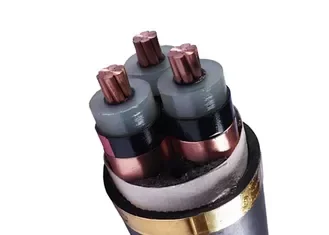Cable insulation is designed to withstand the voltage stresses experienced by the cable during its expected life. Insulation levels define various insulation thicknesses within a single voltage rating. The two most common levels are 100% and 133%. Typically, the 100% insulation level is used for grounding systems, sometimes referred to as the ground insulation thickness. Likewise, the 133% level is commonly used for "ungrounded" systems and is referred to as the ungrounded insulation thickness. There is also an insulation level of 173%, typically used for ungrounded systems that require more time to clear faults.
The specified insulation thickness for each insulation class is similar across various industry standards. Thickness varies with insulation grade and generally thickens as insulation grade increases.Specific insulation thicknesses for voltage ratings up through 46 kV and various conductor sizes are given in National Electrical Manufacturers Association (NEMA), Insulated Cable Engineers Association (ICEA), Underwriters Laboratories (UL), Canadian Standards Association (CSA) and National Fire Protection Association (NFPA) publications.
For cables rated at 0 to 2,000 volts, the working voltage stress on the insulation is very low, so the concept of insulation level is largely unnecessary. For example, the working voltage stress on a typical 600 volt cable is about 5 volts per mil of insulation thickness, which means only 5 volts of electrical stress per mil (0.001 inches) of insulation. On the other hand, the operating voltage stress of a typical 15 kV cable is about 50 V/mil, which is 10 times that of a 600 V cable. Cables rated at 600 volts have thicker insulation per volt of electrical stress applied.
Some applications may require a 173% insulation level for low voltage systems, such as high resistance grounded systems. Most industry standards do not address the 173% insulation level. However, NEMA and ICEA standards, such as ICEA S-95-658-1999 Standard for Unshielded Power Cables Rated 2000 V or Less for Power Distribution, recommend using a cable voltage rated at least 1.73 times the phase-to-phase system. For example, a 480 volt system requires a cable rated at least 830 volts. Due to commercial availability, 1 kV rated cables are typically used for such applications in Canada, while 2 kV cables will be used in the US.
The level of cable insulation required for a particular application depends on how fast the protection relay is designed to de-energize the electrical system in the event of an electrical ground fault. A ground fault is an electrical short circuit from one phase (one conductor) of an electrical system to ground. If the protection relay is set to de-energize the system within one minute, a cable with a 100% insulation level is sufficient according to industry standards. If the protection relay is designed to de-energize the system within one hour, a cable with insulation rating of 133% is required. If the protection relay is designed to de-energize the system after an indefinite period, a cable with a 173% insulation rating is required.

Insulated cable exporter
Shenghua Cable Co., Ltd., an excellent insulated cable manufacturer, sells various types of high-quality insulated cables. If you want to know more about cables, or are interested in our products, you can visit the website of Shenghua Cable Co., Ltd. to contact us.